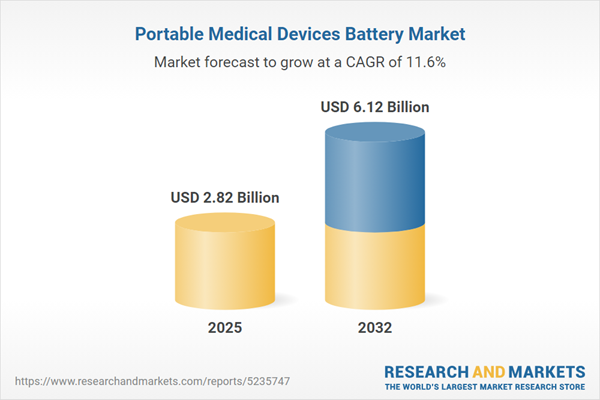Speak directly to the analyst to clarify any post sales queries you may have.
The portable medical devices battery market is experiencing significant evolution as senior healthcare leaders prioritize solutions that deliver both reliability and flexibility. Increasing integration of advanced battery technologies directly supports operational performance and enables care delivery across a broader spectrum of clinical settings.
Market Snapshot: Portable Medical Devices Battery Market
Currently valued at USD 2.53 billion in 2024, the portable medical devices battery market is projected to achieve USD 2.82 billion by 2025, reflecting a compound annual growth rate (CAGR) of 11.64%. Expansion is closely linked to the widespread adoption of next-generation battery chemistries, such as lithium ion and solid-state batteries, across critical healthcare applications. Technological advances are intersecting with key trends, including the acceleration of digital health, expanded care models beyond hospital walls, and the growing necessity for reliable, long-duration power in portable medical equipment. These market forces are complemented by evolving regulations and the emergence of distributed care models, underscoring the critical value of robust battery management and well-structured procurement strategies in all global regions.
Scope & Segmentation
- Device Types: Defibrillators, imaging systems, infusion pumps, patient monitors, and ventilators are vital to both acute intervention and ambulatory care, supporting a range of procedures from in-hospital emergencies to ongoing remote monitoring.
- Infusion Pump Subtypes: Syringe and volumetric infusion pumps rely on battery designs focused on precision and safety, facilitating therapies in clinical and home environments.
- Patient Monitor Subtypes: Portable and wearable monitors require lightweight and high-capacity batteries, enabling dependable ambulatory care as well as continuous health data capture.
- Battery Types: Lead acid, nickel metal hydride, and lithium ion cells are offered in multiple formats—including cylindrical, pouch, and prismatic—to suit specialized clinical equipment and meet stringent compliance standards.
- End Users: Hospitals, ambulatory clinics, emergency services, homecare providers, and healthcare professionals shape procurement practices to align battery specifications with device performance and care intensity.
- Distribution Channels: Direct sales, distributor networks, and digital commerce platforms address the varying needs of centralized health systems and distributed care networks.
- Regional Coverage: The Americas, Europe, Asia-Pacific, Middle East, and Africa each display specific regulatory environments and supply chain challenges, influencing how portable medical device batteries are adopted and supplied locally.
- Key Regional Markets: Countries driving infrastructure and evolving patient care models include the United States, Canada, Mexico, Brazil, Argentina, United Kingdom, Germany, France, China, India, Japan, South Korea, and Australia.
- Companies Analyzed: The market assessment covers firms such as Panasonic Corporation, Energizer Holdings, Duracell U.S. Operations, Saft Groupe, GS Yuasa, VARTA AG, Ultralife Corporation, EVE Energy, Samsung SDI, and Toshiba Corporation, all of which contribute specialized technologies and broad geographic reach.
Key Takeaways for Senior Decision-Makers
- Ongoing advancements in lithium ion and solid-state battery tech are broadening the functional range of portable devices, supporting clinical workflows across multiple environments.
- Procurement priorities must reflect new care delivery frameworks, with adaptability in sourcing strategies to match device demands and care locations.
- Strategic supplier diversification improves business resilience, reducing risk exposure to regional production disruptions and tightening supply chains.
- Elevated focus on international compliance and ethical sourcing criteria is important for supplier selection and long-term partnership stability.
- The adoption of digital procurement channels enables rapid alignment with fluctuating operational requirements and improves overall supply flexibility.
- Emphasizing sustainable sourcing approaches and leveraging local distribution networks positions organizations to better anticipate technological and clinical shifts.
Tariff Impact on the United States Supply Chain
Recent tariff policy adjustments have prompted manufacturers in the U.S. to strengthen domestic supplier relationships and refine logistics management. This approach delivers greater supply chain flexibility and safeguards access to essential medical device batteries, supporting the continuity of care delivery.
Methodology & Data Sources
The market analysis is informed through direct engagement with industry leaders, technical benchmarking, regulatory tracking, and a global review of supply chain operations. Scenario-based forecasting aids in shaping technology roadmaps and procurement decisions for stakeholders in the portable medical devices battery sector.
Why This Report Matters
- Delivers strategic insights to support optimized battery technology selection and procurement processes, accommodating shifts in healthcare delivery models.
- Equips leaders to prepare for regulatory and operational developments, promoting resilient and proactive planning as technology and market needs change.
- Facilitates collaboration with suppliers to uphold standards in patient care and adapt to dynamic clinical expectations.
Conclusion
Maintaining awareness of battery innovation and procurement best practices ensures reliable device operation. Organizations that adopt agile planning and strategic supplier partnerships are better positioned for evolving clinical and operational realities.
Additional Product Information:
- Purchase of this report includes 1 year online access with quarterly updates.
- This report can be updated on request. Please contact our Customer Experience team using the Ask a Question widget on our website.
Table of Contents
3. Executive Summary
4. Market Overview
7. Cumulative Impact of Artificial Intelligence 2025
Companies Mentioned
The companies profiled in this Portable Medical Devices Battery market report include:- Panasonic Corporation
- Energizer Holdings, Inc.
- Duracell U.S. Operations, Inc.
- Saft Groupe S.A.
- GS Yuasa Corporation
- VARTA AG
- Ultralife Corporation
- EVE Energy Co., Ltd.
- Samsung SDI Co., Ltd.
- Toshiba Corporation
Table Information
| Report Attribute | Details |
|---|---|
| No. of Pages | 188 |
| Published | October 2025 |
| Forecast Period | 2025 - 2032 |
| Estimated Market Value ( USD | $ 2.82 Billion |
| Forecasted Market Value ( USD | $ 6.12 Billion |
| Compound Annual Growth Rate | 11.6% |
| Regions Covered | Global |
| No. of Companies Mentioned | 11 |









